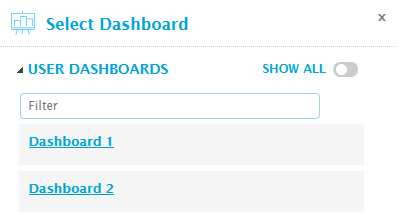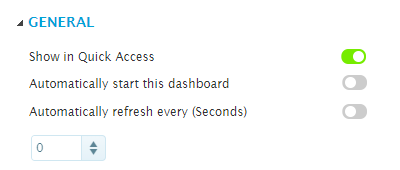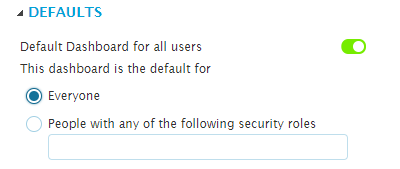Dashboard Controls
In This Topic...
At the top of the dashboard is a drop-down toolbar panel.

Click anywhere on the header to open the panel. This contains various options divided into groups.
The Dashboard group includes the following options for the currently selected dashboard.
|
|
Refresh | Reloads all data in the current dashboard. |
|
|
Back | When using links or controls that navigate between dashboards, the Back button will step back to the previous dashboard. |
|
|
Open | Opens the Select Dashboard panel to load a saved dashboard. |
|
|
Save | Saves all user preferences and settings for the current dashboard. |
|
|
Notes | Opens the Notes panel to add notes related to the current dashboard. |
|
|
Snaps | Opens the Snapshots panel to view and manage snapshots. |
|
|
Export | Opens the Export Options panel to save the current dashboard as a PDF file. |
|
|
Pause | When the dashboard is set to automatically refresh, the Pause button stops the refresh until unpaused. |
|
|
Design | Shifts to the |
|
|
Options | Opens the Dashboard Configuration panel to change the settings for the current dashboard. |
|
|
Query | Opens the Query Editor panel to create and manage custom queries. |
|
|
Share | Opens the Share Configuration panel to configure sharing with mobile devices. |
|
|
Quick | Adds or removes the current dashboard from the Quick Access group. If there are no dashboards in the Quick Access group, the group is hidden. |
|
|
Auto | Makes the current dashboard the default when opening the current instance of SmartView. Only one dashboard at a time can be set to Auto. If SmartView is accessed from different locations (instances), each instance can have its own Auto settings. |
The Quick Access group lists the available dashboards that have been marked for quick access. This is used to quickly switch from one dashboard to another.
Select Dashboard Panel
The Select Dashboard panel opens to the right of the screen when selecting Open from the Dashboard group. Click X to close the panel again.
The dashboards are displayed by category. Each category can be expanded or collapsed using the  and
and  icons.
icons.
The User Dashboards category includes all dashboards that you have marked for Quick Access, currently or in the past.
Click Show All to display all available dashboards. This includes dashboards that you have created, dashboards that have been marked as available to everyone, and dashboards that you can access due to a security role.
Click the name of a dashboard to open it.
Dashboard Configuration Panel
The Dashboard Configuration panel opens to the right of the screen when selecting Options from the Dashboard group, and contains settings for the currently selected dashboard. Click X to close the panel again.
The options are displayed by category. Each category can be expanded or collapsed using the  and
and  icons.
icons.
The General category includes the following options.
The Data Views category allows each data view in the dashboard to be deactivated. This disables the dataview, including any connections it may have to other dataviews.
The Defaults category is used to define the current dashboard as the initial default dashboard for new users. Note that this will not affect users that have selected preferred dashboards.















